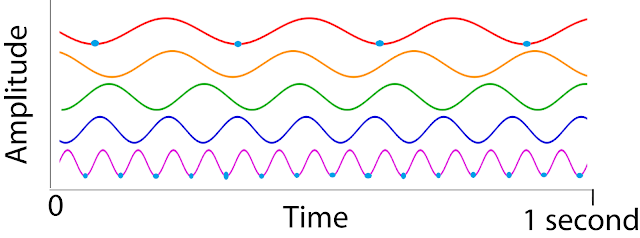Frequency & Waves Scioly Quiz

AUGS Science Olympiad Sounds of Music Frequency & Waves Quiz. How well do you know frequency & waves?
- 1.
A long wavelength means:
- A.
Low frequency
- B.
High frequency
Correct Answer
A. Low frequencyExplanation
A long wavelength refers to the distance between two consecutive peaks or troughs of a wave. In the context of frequency, a long wavelength corresponds to a low frequency. This means that the wave oscillates at a slower rate, with fewer cycles occurring per unit of time. As a result, the wave has a lower pitch or tone. Conversely, a short wavelength corresponds to a high frequency, indicating a faster oscillation rate with more cycles occurring per unit of time and a higher pitch or tone.Rate this question:
-
- 2.
If the amplitude is greater the note is:
- A.
Quieter
- B.
Louder
Correct Answer
B. LouderExplanation
The given question is asking about the relationship between the amplitude of a note and its loudness. Amplitude refers to the maximum displacement or intensity of a sound wave. In general, the greater the amplitude of a sound wave, the louder the note will be perceived. Therefore, the correct answer is "Louder."Rate this question:
-
- 3.
Fill in the blank: The more _____ the sound wave has the louder the sound seems. The intensity of a sound is the amount of _____ it has.
Correct Answer
EnergyExplanation
The more energy the sound wave has, the louder the sound seems. The intensity of a sound is directly related to the amount of energy it possesses.Rate this question:
- 4.
This wave is (check multiple boxes):
- A.
Quiet
- B.
Loud
- C.
Low Pitched
- D.
High Pitched
Correct Answer(s)
B. Loud
D. High PitchedExplanation
This wave is described as loud because it produces a high intensity of sound. Additionally, it is high-pitched because it has a high frequency, meaning it produces a higher number of vibrations per second.Rate this question:
-
- 5.
Which of these waves has the lowest frequency?
- A.
Red
- B.
Orange
- C.
Green
- D.
Blue
- E.
Purple
Correct Answer
A. RedExplanation
Red has the lowest frequency among these waves. Frequency refers to the number of complete cycles of a wave that occur in a given amount of time. Red light has the longest wavelength among visible light, which means it has the lowest frequency. In the visible light spectrum, red light has the lowest energy and is associated with longer wavelengths.Rate this question:
-
- 6.
This symbol stands for:
- A.
Frequency
- B.
Amplitude
- C.
Wavelength
- D.
1 Cycle
Correct Answer
C. WavelengthExplanation
Wavelength is the distance between two consecutive points in a wave that are in phase. It is represented by the symbol λ. In the context of the question, the symbol stands for wavelength because it is the only option that accurately represents the concept of distance in a wave. Frequency refers to the number of cycles of a wave that occur in a unit of time, amplitude represents the maximum displacement of a wave from its equilibrium position, and 1 cycle simply refers to one complete oscillation of a wave.Rate this question:
-
- 7.
After one compression and one rarefaction, one _______ of the wave has passed
Correct Answer
cycleExplanation
After one compression and one rarefaction, one complete oscillation or cycle of the wave has passed. A wave cycle refers to the complete pattern of the wave, starting from a point of equilibrium, going through compression (where the particles are close together), then rarefaction (where the particles are spread apart), and returning back to the equilibrium point. Therefore, after one compression and one rarefaction, the wave has completed one full cycle.Rate this question:
- 8.
The positive amplitude is a:
- A.
Compression
- B.
Rarefaciton
Correct Answer
A. CompressionExplanation
The positive amplitude refers to the maximum displacement of a wave from its equilibrium position. In the case of a compression, the particles of the medium are pushed closer together, resulting in a region of high pressure and density. This corresponds to a positive amplitude as the displacement is in the positive direction from the equilibrium position. Therefore, the correct answer is compression.Rate this question:
-
Quiz Review Timeline +
Our quizzes are rigorously reviewed, monitored and continuously updated by our expert board to maintain accuracy, relevance, and timeliness.
-
Current Version
-
Mar 21, 2023Quiz Edited by
ProProfs Editorial Team -
Feb 22, 2014Quiz Created by
MissCalculated
 Back to top
Back to top




